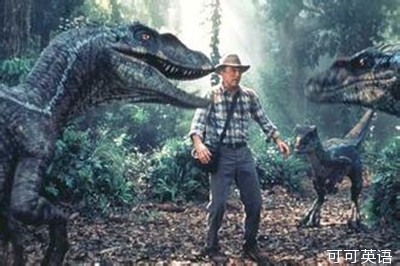(单词翻译:单击)
Tons of dinosaur fossils have been unearthed over the last hundred years.
过去的一百年来,大量恐龙化石被发掘。
These long-buriedbones tell us about the physical build and eating habits of dinosaurs.
这些长埋的骨头告诉我们恐龙的体质和饮食习惯。
But to tell how dinosaurs livedand behaved, you often need more than bones.
但为了弄清恐龙的生活习性,你通常需要更多的骨头。
That's why the earliest dinosaur nests found todate are giving up secrets about dinosaurs that lived one hundred ninety million years ago.
这就是为什么迄今为止发现的最早的恐龙巢穴能够披露生活在一亿九千万年前的恐龙的秘密。

Massospondylus, whose name means “longer vertebrae,” was a two legged, omnivore that wasfrom thirteen to twenty feet long and weighed three hundred pounds.
大椎龙,顾名思义,就是有更长的椎骨,两条腿,长13到20英尺,重达300磅的杂食动物。
Its small head was perchedon a long neck and its forelimbs were armed with sharp thumb claws.
它的小脑袋长在长长的脖子上,前肢装备着锋利的拇指爪子。
An archeological site at Golden Gate Highlands National Park in SouthAfrica has been a treasuretrove of information for scientists.
南非金门高地国家公园的考古遗址一直是科学家的信息宝库。
Ten nests have been unearthed at several levels of the site.
这里的几个地方曾出土了10个不同等级的巢穴,
Each contains up to thirty four round eggs tightly clustered.
每个巢穴中有多达三、四十枚紧密聚集在一起的圆蛋。
Both eggs and dinosaur embryoshave been examined.
蛋和恐龙胚胎都做了检测。
The site not only gives us physical information, it shines some light on the behavior of these earlydinosaurs.
这些遗址不仅给我们提供物体信息,还指引我们弄清早期恐龙的习性。
It confirms that even early dinosaurs built nests in groups, similar to colonial birdsnesting today.
它证实了即使是早期恐龙也是集体筑巢的,与今天殖民鸟类筑巢相似。
Despite their menacing claws, Massospondylus mothers kept highly organizednests, suggesting that they may have arranged the eggs in their nest after laying them.
尽管有具威胁性的爪子,长椎龙妈妈在筑巢时礽保持着高度的组织性,这可能暗示着她们产蛋后会将其整理好。
Nest locations within the strata indicate that the dinosaurs returned to the site year after year.
筑巢点的地层表明恐龙会年复一年的返回筑巢地。
This behavior is known as nesting fidelity.
这种行为被称为栖息地忠实性。
Footprints around the nest are also giving us an idea aboutyoung dinosaur behavior. Hatchlings didn't leave the nest site immediately, but stayed in the areauntil they were at least double their hatching size.
巢穴周围的脚印也能帮我们了解小恐龙的习性。幼仔不会立刻离开巢穴,而是一直在该区待到至少是孵化时两倍大小才离开。


